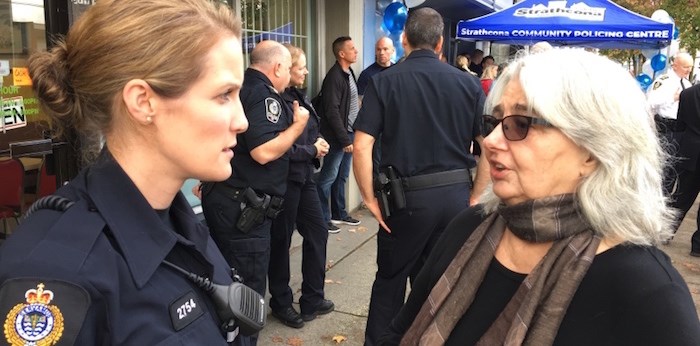An East Hastings Street storefront in Strathcona that used to sell marijuana seeds is now a community policing centre and officially opened its doors Wednesday, despite pushback from a drug users’ group that called for the centre’s funding to be spent on combatting the opioid crisis.
Police Chief Adam Palmer, who attended the opening of the centre at 872 East Hastings, said it took many years to get the facility open and it is overdue for residents and business owners who wanted a hub to address crime and safety issues in the neighbourhood.
 Const. Janine Tanino, the officer assigned to the Strathcona community policing centre, chats Wednesday with Judy McGuire, one of the centre’s board members. The centre at 872 East Hastings officially opened Wednesday. Photo Mike Howell
Const. Janine Tanino, the officer assigned to the Strathcona community policing centre, chats Wednesday with Judy McGuire, one of the centre’s board members. The centre at 872 East Hastings officially opened Wednesday. Photo Mike Howell
“This is a great conduit to bring police, community members and other organizations like [Union Gospel Mission] together to look out for each other,” the chief told the Courier, emphasizing an approach that allows police and community to address problems that can’t always be tackled by patrol officers going from call to call.
Those problems range from garbage and discarded syringes in parks to break-ins to homes and cars. Nuisance premises, problem landlords, people camping in parks, graffiti and street disorder are other issues in a community that has also lost residents to overdose deaths.
The most recent Vancouver police statistics for Strathcona show there were 53 assaults, 51 thefts from vehicles, 59 thefts under $5,000, 32 mischief cases and 24 burglaries in July. Four sex offences and eight incidents involving weapons were also captured in the statistics.
Const. Janine Tanino, the officer assigned to the centre, said her role is to support the community and tackle any problems that pop up—“whether it’s crime, whether it’s the need to work with the children down here, to work with the businesses. There’s such a big diversity in this community.”
Tanino said she is building relationships with some of the children at the neighbouring Ray-Cam community centre. The centre has served as a hub for many years for Strathcona children, including many who live in low-income housing adjacent to Ray-Cam.
“Sometimes they might need an authority figure to talk to them, but sometimes it’s just really getting out there and playing some basketball, or working at the soapbox derby,” she said. “So when the youth need me, I’m there and I’m not just another police officer, I’m not another new face, I’m someone they actually trust—I’m Janine.”
Judy McGuire, a board member at Ray-Cam and at the policing centre, said she welcomed the centre to the neighbourhood, saying it is “awesome.” McGuire said her take on the city providing funding for the centre is that it wasn’t directed at policing, but “community accessibility.”
“It helps make the whole neighbourhood safer, including those people on the street,” she said, noting all volunteers are trained how to use the overdose-reversing drug, naloxone.
The $200,000 for start-up costs and to operate the centre for the first year was approved in a controversial city council vote in December 2016. At the time, the Vision Vancouver-led council successfully passed a .5 per cent tax hike on top of the originally proposed 3.4 per cent increase.
The .5 per cent tax became known as the “fentanyl tax” and would generate $3.5 million to help battle the opioid crisis. Palmer argued Wednesday the centre had been in the works for eight to 10 years and that its funding was not a “knee-jerk reaction” to the opioid crisis, although he acknowledged the crisis “helped move it along.”
The chief said the department continues to support the city’s four pillars drug strategy, including harm reduction and treatment. While talking to the Courier, he pointed out Const. Linda Malcolm in the crowd and said she helped many addicted sex trade workers seek treatment.
While the Vancouver Area Network of Drug Users agreed with many of the measures adopted by council in 2016, including $1.8 million to allow deployment of four Vancouver Fire and Rescue medic teams around the clock, its members argued the centre would not help drug users.
Laura Shaver, a member and past president of the drug users’ organization, said the funding would have been better directed at existing programs or to create new services for drug users. Shaver said the money could have also been spent on services for the homeless and people living with a mental illness.
The most recent overdose death statistics released by the BC Coroners Service show 165 people died in Vancouver in the first five months of this year. More than 1,400 people died across the province last year, with the majority of deaths linked to fentanyl.
“I don’t want to be stigmatizing, and I don’t want not to have faith, but I don’t believe [the centre] will help the majority of drug users in the community going through this genocide right now,” she said, adding the Downtown Eastside is already “over-policed.”
Shaver said she was encouraged to hear the centre’s volunteers were trained how to use naloxone. But she pointed out that drug users are more likely to seek help from peers. They also continue to have a fear of police, whether it be uniformed officers or people associated to a police office, she said.
To break down that barrier, or bridge that gap, Shaver hopes to build a relationship with the policing centre, although she pointed out it’s not off to a good start. She said no one at the drug users’ organization was invited to Wednesday’s official opening.
In approving the “fentanyl tax” in 2016, money was also directed at mental health support for firefighters and frontline city and parks staff, training city staff in overdose management, creating a youth education program targeted at substance abuse and harm reduction and developing a strategy to create treatment-on-demand drug rehabilitation programs.
The city will fund the annual operating costs of the centre, as it does with the other 10 centres. The cost is about $108,000 per year, although non-profits that oversee the centres do raise money to add more programs.
The building is privately owned but the landlords, who attended Wednesday’s opening, declined to be interviewed, although they are said to be happy with the new tenant.
“I think everybody in life has got their own take on where money should be spent,” Palmer added. “Taxpayers’ dollars are a scarce resource and it does have to go into the right programs. But we did have a really good business case for this Strathcona community policing centre.”
Dan Jackson, president of the Strathcona Residents’ Association, said adding a community policing centre to the neighbourhood was long overdue. He noted there are at least 10 others across the city, but the closest to Strathcona are in Chinatown and Grandview-Woodland.
Jackson said the goal is to tackle problems in the community without having to always call police. He provided an example where a bicycle team—“spikes on bikes”—that works in the Downtown Eastside responded to residents’ concerns about syringes piling up in a local park.
“We went to those people and they figured out how to address it at a community level,” Jackson said. “Part of the opioid crisis is about people not feeling they belong to any kind of community. I think that this can hopefully be a way that we can create a bridge so people feel like they belong to a larger community.”



